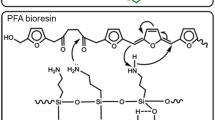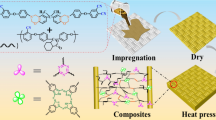Abstract
Fiberglass-reinforced composites composed of a matrix based on novolac-type phenol-hydroxymethylfurfural (PHMF) resins were developed. Using hexamethylenetetramine (HMTA) as a cross-linker, the curing process of the PHMF–HMTA was monitored by thermogravimetric analysis–FTIR analysis, and no formaldehyde emission was detected. The influence of hardener addition from 10–20 wt% was evaluated by mechanical properties, thermal stabilities, and thermochemical properties. Tensile and flexural strengths were as high as 115 and 145 MPa, respectively. The results revealed that the addition of HMTA to PHMF resin led to higher thermal stability of the resin, increased FRC tensile strength and crosslink density. Dynamic mechanical analysis indicated that ~15 wt% HMTA addition is optimal. This study demonstrated that PHMF resin can be used as a polymer matrix for the production of green composites with zero formaldehyde emission upon heating.





Similar content being viewed by others
References
Daoutidis P, Marvin WA, Rangarajan S et al (2013) Engineering biomass conversion processes: a systems perspective. AIChE J 59:3–18
Klemm D, Heublein B, Fink HP et al (2005) Cellulose: fascinating biopolymer and sustainable raw material. Angew Chem Int Ed 44:3358–3393
Rosatella AA, Simeonov SP, Frade RFM et al (2011) 5-Hydroxymethylfurfural (HMF) as a building block platform: biological properties, synthesis and synthetic applications. Green Chem 13:754–793
Röper H (2002) Renewable raw materials in Europe—industrial utilisation of starch and sugar [1]. Starch Stärke 54:89–99
Kowatsch S (2010) In: Pilato L (ed) Phenolic resins: a century of progress. Springer, Berlin
Manjula S, Pavithran C, Pillai CKS et al (1991) Synthesis and mechanical properties of cardanol-formaldehyde (CF) resins and CF-poly (methylmethacrylate) semi-interpenetrating polymer networks. J Mater Sci 26:4001–4007. doi:10.1007/BF02402940
Mutlu I, Alma MH, Basturk MA et al (2005) Preparation and characterization of brake linings from modified tannin-phenol formaldehyde resin and asbestos-free fillers. J Mater Sci 40:3003–3005. doi:10.1007/s10853-005-2396-7
Yuan Z, Zhang Y, Xu C (2014) Synthesis and thermomechanical property study of Novolac phenol-hydroxymethyl furfural (PHMF) resin. RSC Adv 4:31829–31835
Shibata S, Cao Y, Fukumoto I (2008) Flexural modulus of the unidirectional and random composites made from biodegradable resin and bamboo and kenaf fibres. Compos Part A 39:640–646
Suharty NS, Wirjosentono B, Firdaus M et al (2008) Synthesis of degradable bio-composites based on recycle polypropylene filled with bamboo powder using a reactive process. J Phys Sci 19:105–115
Zhang X, Looney MG, Solomon DH et al (1997) The chemistry of novolac resins: 3. 13C and 15N n.m.r. studies of curing with hexamethylenetetramine. Polymer 38:5835–5848
Zhang X, Potter AC, Solomon DH (1998) The chemistry of novolac resins: part 7. Reactions of para-hydroxybenzylamineintermediates. Polymer 39:1957–1966
Lim ASC, Solomon DH, Zhang X (1999) Chemistry of novolac resins. X. Polymerization studies of HMTA and strategically synthesized model compounds. J Appl Polym Sci 37:1347–1355
Markovic S, Dunjic B, Zlatanic A et al (2001) Dynamic mechanical analysis study of the curing of phenol-formaldehyde novolac resins. J Appl Polym Sci 81:1902–1913
Wan J, Wang S, Li C et al (2011) Effect of molecular weight and molecular weight distribution on cure reaction of novolac with hexamethylenetetramine and properties of related composites. Thermochim Acta 530:32–41
Lytle CA, Bertsch W, McKinley M (1998) Determination of novolac resin thermal decomposition products by pyrolysis-gas chromatography-mass spectrometry. J Anal Appl Pyrolysis 45:121–131
Pichelin F, Kamoun C, Pizzi A (1999) Hexamine hardener behaviour: effects on wood glueing, tannin and other wood adhesives. Eur J Wood Wood Prod 57:305–317
Hatfield GR, Maciel GE (1987) Solid-state NMR study of the hexamethylenetetramine curing of phenolic resins. Macromolecules 20:608–615
Pilato L (2010) Phenolic resins: A century of progress. Springer, New York
Mouritz AP, Leong KH, Herszberg I (1997) A review of the effect of stitching on the in-plane mechanical properties of fibre-reinforced polymer composites. Compos Part A 28:979–991
George J, Sreekala MS, Thomas S (2001) A review on interface modification and characterization of natural fiber reinforced plastic composites. Polym Eng Sci 41:1471–1485
Anseth KS, Kline LM, Walker TA et al (1995) Reaction kinetics and volume relaxation during polymerizations of multiethylene glycol dimethacrylates. Macromolecules 28:2491–2499
Zhu J, Chandrashekhara K, Flanigan V et al (2004) Curing and mechanical characterization of a soy-based epoxy resin system. J Appl Polym Sci 91:3513–3518
Holbery J, Houston D (2006) Natural-fiber-reinforced polymer composites in automotive applications. JOM 58:80–86
Espinosa MA, Cádiz V, Galia M (2003) Synthesis and characterization of benzoxazine-based phenolic resins: crosslinking study. J Appl Polym Sci 90:470–481
Kissinger HE (1957) Reaction kinetics in differential thermal analysis. Anal Chem 29:1702–1706
Crane LW, Dynes PJ, Kaelble DH (1973) Analysis of curing kinetics in polymer composites. J Polym Sci Polym Phys Ed 11:533–540
De Medeiros ES, Agnelli JAM, Joseph K et al (2003) Curing behavior of a novolac-type phenolic resin analyzed by differential scanning calorimetry. J Appl Polym Sci 90:1678–1682
Zhang Y, Yuan Z, Xu CC (2015) Engineering biomass into formaldehyde-free phenolic resin for composite materials. AIChE J 61:1275–1283
Acknowledgements
The authors are grateful for the financial support of the NSERC/FPInnovations Industrial Research Chair Program in Forest Biorefinery, Grant IRCSA413630-09, and funding of the Ontario Research Fund-Research Excellence (ORF-RE), Grant IRCPJ413631-09. They are grateful also for the support of the industrial partners including FPInnovations, Arclin Canada, and BioIndustrial Innovation Centre is also acknowledged.
Author information
Authors and Affiliations
Corresponding authors
Rights and permissions
About this article
Cite this article
Zhang, Y., Nanda, M., Tymchyshyn, M. et al. Mechanical, thermal, and curing characteristics of renewable phenol-hydroxymethylfurfural resin for application in bio-composites. J Mater Sci 51, 732–738 (2016). https://doi.org/10.1007/s10853-015-9392-3
Received:
Accepted:
Published:
Issue Date:
DOI: https://doi.org/10.1007/s10853-015-9392-3




